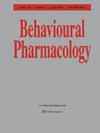研究非典型抗精神病药物氨磺必利的鉴别刺激特性的内在机制
IF 1.6
4区 心理学
Q3 BEHAVIORAL SCIENCES
引用次数: 0
摘要
阿米舒必利是一种非典型苯甲酰胺类抗精神病药/抗抑郁药,其作用机制被认为主要依赖于多巴胺D2/3受体的活性,但也有一定的5-羟色胺5-HT2B/7效应。本研究考察了 D2/3 受体和 5-HT2B/7 受体在氨磺必利的辨别刺激中的作用。研究人员对成年雄性 C57BL/6 小鼠进行了上述受体的选择性激动剂和拮抗剂试验,训练其在双杠杆药物辨别试验中辨别 10 mg/kg 阿米舒必利和车辆。在获得双杠杆辨别能力后,氨磺必利泛化曲线得出 ED50 = 0.56 mg/kg(95% CI = 0.42-0.76 mg/kg)。替代试验发现,D2/3 拮抗剂拉克必利(62.7% 药物杠杆反应)、D2/3 激动剂喹吡罗(56.6% DLR)、5-HT7 激动剂 LP-44(50.1% DLR)和 5-HT7 拮抗剂 SB-269970 (36.而 5-HT2B 激动剂 BW 723C86(17.9% DLR)和 5-HT2B 拮抗剂 SB-204741(21.1% DLR)产生的氨磺必利类效应可忽略不计。在与氨磺必利的联合试验中,喹吡罗的反应百分率从 98.3% 下降到 57.0% DLR,LP-44 的反应百分率从 97.6% 下降到 76.7% DLR,而 BW 723C86 的反应百分率从 95.66% 下降到 74.11% DLR。总之,刺激泛化和拮抗研究的结果表明,氨磺必利具有复杂的辨别线索,主要涉及 D2/3 受体拮抗剂/兴奋剂混合效应,其次是 5-HT7 受体激动剂/兴奋剂混合效应,或许还有 5-HT2B 受体拮抗剂效应。本文章由计算机程序翻译,如有差异,请以英文原文为准。
Examination of the mechanisms underlying the discriminative stimulus properties of the atypical antipsychotic amisulpride
Amisulpride is an atypical benzamide antipsychotic/antidepressant, whose mechanism of action is thought to depend mainly on dopamine D2/3 receptor activity, but also with some serotonin 5-HT2B/7 effects. The present study examined the role of D2/3 receptors and 5-HT2B/7 receptors in amisulpride’s discriminative stimulus. Selective agonists and antagonists of the above receptors were tested in adult, male C57BL/6 mice trained to discriminate 10 mg/kg amisulpride from vehicle in a two-lever drug discrimination assay. After acquisition of the two-lever discrimination, the amisulpride generalization curve yielded an ED50 = 0.56 mg/kg (95% CI = 0.42–0.76 mg/kg). Substitution tests found that the D2/3 antagonist raclopride (62.7% Drug Lever Responding), D2/3 agonist quinpirole (56.6% DLR), 5-HT7 agonist LP-44 (50.1% DLR) and 5-HT7 antagonist SB-269970 (36.7% DLR) produced various degrees of partial substitution for the amisulpride stimulus, whereas the 5-HT2B agonist BW 723C86 (17.9% DLR) and 5-HT2B antagonist SB-204741 (21.1% DLR) yielded negligible amisulpride-like effects. In combination tests with amisulpride, quinpirole decreased percent responding from 98.3% to 57.0% DLR, LP-44 decreased percent responding from 97.6% to 76.7% DLR, and BW 723C86 reduced percent responding from 95.66% to 74.11% DLR. Taken together, the results from stimulus generalization and antagonism studies suggest that amisulpride has a complex discriminative cue that involves mainly mixed D2/3 receptor antagonist/agonist effects and, to a lesser degree, mixed 5-HT7 receptor agonist/antagonist and perhaps 5-HT2B receptor antagonist effects.
求助全文
通过发布文献求助,成功后即可免费获取论文全文。
去求助
来源期刊

Behavioural Pharmacology
医学-行为科学
CiteScore
3.40
自引率
0.00%
发文量
84
审稿时长
6-12 weeks
期刊介绍:
Behavioural Pharmacology accepts original full and short research reports in diverse areas ranging from ethopharmacology to the pharmacology of schedule-controlled operant behaviour, provided that their primary focus is behavioural. Suitable topics include drug, chemical and hormonal effects on behaviour, the neurochemical mechanisms under-lying behaviour, and behavioural methods for the study of drug action. Both animal and human studies are welcome; however, studies reporting neurochemical data should have a predominantly behavioural focus, and human studies should not consist exclusively of clinical trials or case reports. Preference is given to studies that demonstrate and develop the potential of behavioural methods, and to papers reporting findings of direct relevance to clinical problems. Papers making a significant theoretical contribution are particularly welcome and, where possible and merited, space is made available for authors to explore fully the theoretical implications of their findings. Reviews of an area of the literature or at an appropriate stage in the development of an author’s own work are welcome. Commentaries in areas of current interest are also considered for publication, as are Reviews and Commentaries in areas outside behavioural pharmacology, but of importance and interest to behavioural pharmacologists. Behavioural Pharmacology publishes frequent Special Issues on current hot topics. The editors welcome correspondence about whether a paper in preparation might be suitable for inclusion in a Special Issue.
 求助内容:
求助内容: 应助结果提醒方式:
应助结果提醒方式:


